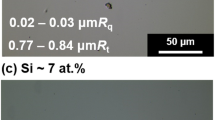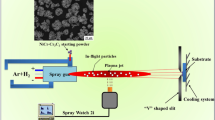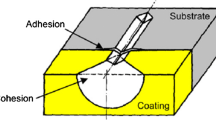Abstract
Carbide-derived carbon (CDC) coatings with dimple (CDC@GSiC coating) and loosely dispersive particles structures (CDC@RBSiC coating) were prepared on two kinds of SiC substrates by using chlorination at 1,000 °C in a 5 vol.% Cl2–Ar gas. Microstructural effect makes the two CDC coatings exhibit different frictional behavior in ambient pressure and in vacuum. For the CDC@RBSiC coating, the friction coefficient was from 0.08 to 0.12 at ambient pressure and is sensitive to evacuation from ambient pressure to 103 Pa while it was as high as 0.42 up to a pressure of 10−4 Pa. Progressive evacuation does not vary the friction coefficient of the CDC@GSiC coating up to 10−3 Pa. The wear of the CDC@GSiC coating was low with a maximum depth of 8 μm and much lower than that of the CDC@RBSiC coating (70 μm). The dimples on the surface and pores in the CDC@GSiC coating are reservoirs for ion liquid (IL), and the IL impregnated CDC@GSiC coating shows very low friction and wear at ambient pressure and in vacuum.








Similar content being viewed by others
References
McNallan, M., Ersoy, D., Zhu, R., Lee, A., White, C., Welz, S., Gogotsi, Y., Erdemir, A., Kovalchenko, A.: Nano-structured carbide derived carbon films and their tribology. Tsinghua Sci. Technol. 10, 699–703 (2005)
Erdemir, A., Kovalchenko, A., McNallan, M.J., Welz, S., Lee, A., Gogotsi, Y., Carroll, B.: Effects of high temperature hydrogenation treatment on sliding friction and wear behavior of carbide derived carbon films. Surf. Coat. Technol. 188–189, 588–593 (2004)
Sui, J., Lu, J.: Formulated self-lubricating carbon coatings on carbide ceramics. Wear 271, 1974–1979 (2011)
Carroll, B., Gogotsi, Y., Kovalchenko, A., Erdemir, A., McNallan, M.J.: Effect of humidity on the tribological properties of carbide-derived carbon (CDC) films on silicon carbide. Tribol. Lett. 15, 51–55 (2003)
Sui, J., Lu, J.: Friction and wear behavior of carbide derived carbon coating sliding against Si3N4 under the lubrication of water. Tribology 31, 498–503 (2011). (in Chinese)
Gao, F., Lu, J., Liu, W.: Comparison on the tribological behavior of carbide-derived carbon and graphite in air. Tribology 27, 102–105 (2007). (in Chinese)
Gao, F., Lu, J., Liu, W.: Tribological behavior of carbide-derived carbon coating on SiC polycrystal against SAE52100 steel in moderately humid air. Tribol. Lett. 27, 339–345 (2007)
Ischenko, V., Jang, Y.-S., Kormann, M., Greil, P., Popovska, N., Zollfrank, C., Woltersdorf, J.: The effect of SiC substrate microstructure and impurities on the phase formation in carbide-derived carbon. Carbon 49, 1189–1198 (2011)
Gogotsi, Y., Nikitin, A., Ye, H., Zhou, W., Fischer, J.E., Yi, B., Foley, H.C., Barsoum, M.W.: Nanoporous carbide-derived carbon with tunable pore size. Nat. Mater. 2, 591–594 (2003)
Yushin, G., Dash, R., Jagiello, J., Fischer, J.E., Gogotsi, Y.: Carbide-derived carbons effect of pore size on hydrogen uptake and heat of adsorption. Adv. Funct. Mater. 16, 2288–2293 (2006)
Welton, T.: Room-temperature ionic liquids. Solvents for synthesis and catalysis. Chem. Rev. 99, 2071–2084 (1999)
Hagiwara, R., Ito, Y.: Room temperature ionic liquids of alkylimidazolium cations and fluoroanions. J. Fluorine Chem. 105, 221–227 (2000)
Urbonaite, S., Hälldahl, L., Svensson, G.: Raman spectroscopy studies of carbide derived carbons. Carbon 46, 1942–1947 (2008)
Gogotsi, Y.G., Yoshimura, M.: Formation of carbon films on carbide under hydrothermal condition. Nature 367, 628–630 (1994)
Ferrari, A.C., Robertson, J.: Interpretation of Raman spectra of disordered and amorphous carbon. Phys. Rev. B 61, 14095–14107 (2000)
Forrest, C., Kennedy, P., Shennan, J.: The fabrication and properties of self-bonded silicon carbide bodies. Spec. Ceram. 5, 99–123 (1972)
Andersson, J., Erck, R.A., Erdemir, A.: Frictional behavior of diamondlike carbon films in vacuum and under varying water vapor pressure. Surf. Coat. Technol. 163–164, 535–540 (2003)
Hoffman, E.N., Yushin, G., El-Raghy, T., Gogotsi, Y., Barsoum, M.W.: Micro and mesoporosity of carbon derived from ternary and binary metal carbides. Microporous Mesoporous Mater. 112, 526–532 (2008)
Acknowledgments
The present work was financially supported by National Natural Science Foundation of China (No. 51075382).
Author information
Authors and Affiliations
Corresponding author
Rights and permissions
About this article
Cite this article
Liu, F., Guo, H., Ma, W. et al. Low Friction Carbide-Derived Carbon Coating on SiC in Vacuum Achieved by Microstructure Formulation and Solid–Liquid Lubrication. Tribol Lett 54, 183–190 (2014). https://doi.org/10.1007/s11249-014-0325-0
Received:
Accepted:
Published:
Issue Date:
DOI: https://doi.org/10.1007/s11249-014-0325-0




